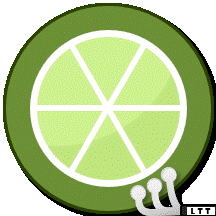-
Posts
28,442 -
Joined
-
Last visited
Reputation Activity
-
 minibois got a reaction from BlackVirus in (De)Soldering for Beginners - Need help [Photos]
minibois got a reaction from BlackVirus in (De)Soldering for Beginners - Need help [Photos]
That's a great point to mention, this capacitor is connected to something (likely positive voltage), but also to ground (GND for short):
That might explain this point:
Simply put, a PCB consists of fibreglass, with layer(s) of copper adhered to it. This copper is removed in some places to make the traces, which connect the different components together. One of the most common connection point for these devices is ground (or GND for short). This capacitor is also connected to ground.
The copper on the board and the components attached to it act like a heatsink, soaking up the heat in the copper/components. A component that has a legs only attached to itself and maybe one/two other components heat up rather quickly, but a component attached to ground (or a similarly large area) will have a lot of copper on the PCB and components to soak up the heat from your soldering iron.
One of the legs of the capacitor - the ground leg - will be extremely difficult/time consuming to heat up entirely, because of all the heatsoak ability of the copper/rest of the components.
It might be easier to look for a component to desolder that isn't attached to ground; but those are rather uncommon. Ground connections can be recognized by the large connection points (the lighter blue) on the board. Large connection points could also be a positive voltage line though, which still have a large network attached; just often not as large as ground.
TL;DR: one of the legs on the capacitor has a lot of copper attached to it, so is difficult to heat up entirely.
While I agree this is a great idea for someone wanting to learn how to solder, these kits don't teach you how to desolder though, that is what donor boards are great for.
-
 minibois got a reaction from BlackVirus in (De)Soldering for Beginners - Need help [Photos]
minibois got a reaction from BlackVirus in (De)Soldering for Beginners - Need help [Photos]
There are mainly two types of components in regards to soldering; SMD and THT. SMD or THT, which stand of surface mount device and through hole technology.
As the names imply, SMD are soldered to the surface of the board using pads, while THT components have legs that stick through the board and are soldered in place like that.
What you are trying to desolder is a capacitor indeed, of the THT variety. While desoldering braid works very well for SMD, THT is typically easier done with a desoldering pump like what @SorryClaireshowed.
You first heat the solder, then the pump sucks away the now liquid state solder, which can lead to very clean desolder jobs.
Due to various reasons (such as environmental reasons), most devices will use soldertin with no lead. Solder with lead is easier to work with*, due to its lower temperature of becoming liquid. If you have some leaded soldertin, it is usually recommended to heat up the solder joint and add some leaded soldertin, to make the entire joint turn liquid quicker.
So my general workflow with removing a THT component is:
1. Add some leaded solder
2. Heat the joint and suck away the soldertin using a pump
3. Repeat step 2. until the component is free to remove and move to the next leg(s)
*lead can be dangerous, just like the fumes that come free while soldering. Make sure you're in a well-ventilated area and clean your hands after soldering.
Soldering braid is a bunch of copper wires braided together, infused with some flux. The braid will make it so the soldertin has some place to infuse into the braid, while the flux aids in 'attracting' the tin. It often helps to add some flux to the board when desoldering, especially because the flux further down in the braid can be evaporated by the time you reach that part of the braid.
Usually it's recommend to add a bit of solder to the end of your iron's tip, that just aids in the efficient tranfers of heat between your iron and the braid.
So my basic use with soldering braid (which I mostly use for SMD, or removing some residual soldertin) involves:
1. Add some fresh leaded solder
2. Add some flux to the joint
3. Add some tin to the end of my soldering iron
4. touch the braid to the joint, then the "soldertin added side" of the iron's tip to the braid
These are just some general workflow patterns I prefer to use, feel free to experiment.
The temperature of your iron should honestly be fine for leaded solder or just soldering in general, but unleaded solder can just be a pain to work with.
Another general tip, if you're done soldering add a bunch of soldertin to your iron's tip, that adds a type of layer of 'coating' to the iron's tip, since the tip could either oxidize (rust) pretty quickly.
Hope some of these tips help you! Great idea of starting with a 'practice board', so you get the hang of soldering before attempting to work on other projects 🙂
-
 minibois got a reaction from The_russian in (De)Soldering for Beginners - Need help [Photos]
minibois got a reaction from The_russian in (De)Soldering for Beginners - Need help [Photos]
That's a great point to mention, this capacitor is connected to something (likely positive voltage), but also to ground (GND for short):
That might explain this point:
Simply put, a PCB consists of fibreglass, with layer(s) of copper adhered to it. This copper is removed in some places to make the traces, which connect the different components together. One of the most common connection point for these devices is ground (or GND for short). This capacitor is also connected to ground.
The copper on the board and the components attached to it act like a heatsink, soaking up the heat in the copper/components. A component that has a legs only attached to itself and maybe one/two other components heat up rather quickly, but a component attached to ground (or a similarly large area) will have a lot of copper on the PCB and components to soak up the heat from your soldering iron.
One of the legs of the capacitor - the ground leg - will be extremely difficult/time consuming to heat up entirely, because of all the heatsoak ability of the copper/rest of the components.
It might be easier to look for a component to desolder that isn't attached to ground; but those are rather uncommon. Ground connections can be recognized by the large connection points (the lighter blue) on the board. Large connection points could also be a positive voltage line though, which still have a large network attached; just often not as large as ground.
TL;DR: one of the legs on the capacitor has a lot of copper attached to it, so is difficult to heat up entirely.
While I agree this is a great idea for someone wanting to learn how to solder, these kits don't teach you how to desolder though, that is what donor boards are great for.
-
 minibois got a reaction from The_russian in (De)Soldering for Beginners - Need help [Photos]
minibois got a reaction from The_russian in (De)Soldering for Beginners - Need help [Photos]
There are mainly two types of components in regards to soldering; SMD and THT. SMD or THT, which stand of surface mount device and through hole technology.
As the names imply, SMD are soldered to the surface of the board using pads, while THT components have legs that stick through the board and are soldered in place like that.
What you are trying to desolder is a capacitor indeed, of the THT variety. While desoldering braid works very well for SMD, THT is typically easier done with a desoldering pump like what @SorryClaireshowed.
You first heat the solder, then the pump sucks away the now liquid state solder, which can lead to very clean desolder jobs.
Due to various reasons (such as environmental reasons), most devices will use soldertin with no lead. Solder with lead is easier to work with*, due to its lower temperature of becoming liquid. If you have some leaded soldertin, it is usually recommended to heat up the solder joint and add some leaded soldertin, to make the entire joint turn liquid quicker.
So my general workflow with removing a THT component is:
1. Add some leaded solder
2. Heat the joint and suck away the soldertin using a pump
3. Repeat step 2. until the component is free to remove and move to the next leg(s)
*lead can be dangerous, just like the fumes that come free while soldering. Make sure you're in a well-ventilated area and clean your hands after soldering.
Soldering braid is a bunch of copper wires braided together, infused with some flux. The braid will make it so the soldertin has some place to infuse into the braid, while the flux aids in 'attracting' the tin. It often helps to add some flux to the board when desoldering, especially because the flux further down in the braid can be evaporated by the time you reach that part of the braid.
Usually it's recommend to add a bit of solder to the end of your iron's tip, that just aids in the efficient tranfers of heat between your iron and the braid.
So my basic use with soldering braid (which I mostly use for SMD, or removing some residual soldertin) involves:
1. Add some fresh leaded solder
2. Add some flux to the joint
3. Add some tin to the end of my soldering iron
4. touch the braid to the joint, then the "soldertin added side" of the iron's tip to the braid
These are just some general workflow patterns I prefer to use, feel free to experiment.
The temperature of your iron should honestly be fine for leaded solder or just soldering in general, but unleaded solder can just be a pain to work with.
Another general tip, if you're done soldering add a bunch of soldertin to your iron's tip, that adds a type of layer of 'coating' to the iron's tip, since the tip could either oxidize (rust) pretty quickly.
Hope some of these tips help you! Great idea of starting with a 'practice board', so you get the hang of soldering before attempting to work on other projects 🙂
-
 minibois got a reaction from Eschew in (De)Soldering for Beginners - Need help [Photos]
minibois got a reaction from Eschew in (De)Soldering for Beginners - Need help [Photos]
That's a great point to mention, this capacitor is connected to something (likely positive voltage), but also to ground (GND for short):
That might explain this point:
Simply put, a PCB consists of fibreglass, with layer(s) of copper adhered to it. This copper is removed in some places to make the traces, which connect the different components together. One of the most common connection point for these devices is ground (or GND for short). This capacitor is also connected to ground.
The copper on the board and the components attached to it act like a heatsink, soaking up the heat in the copper/components. A component that has a legs only attached to itself and maybe one/two other components heat up rather quickly, but a component attached to ground (or a similarly large area) will have a lot of copper on the PCB and components to soak up the heat from your soldering iron.
One of the legs of the capacitor - the ground leg - will be extremely difficult/time consuming to heat up entirely, because of all the heatsoak ability of the copper/rest of the components.
It might be easier to look for a component to desolder that isn't attached to ground; but those are rather uncommon. Ground connections can be recognized by the large connection points (the lighter blue) on the board. Large connection points could also be a positive voltage line though, which still have a large network attached; just often not as large as ground.
TL;DR: one of the legs on the capacitor has a lot of copper attached to it, so is difficult to heat up entirely.
While I agree this is a great idea for someone wanting to learn how to solder, these kits don't teach you how to desolder though, that is what donor boards are great for.
-
 minibois reacted to Levent in (De)Soldering for Beginners - Need help [Photos]
minibois reacted to Levent in (De)Soldering for Beginners - Need help [Photos]
Starting on a copper heavy consumer motherboard is not the correct way to go. These are not easy to desolder from. Dont waste any time and effort on this board, get DIY kits from ebay and start from basics.
-
 minibois got a reaction from Eschew in SSD DOES NOT SHOW UP
minibois got a reaction from Eschew in SSD DOES NOT SHOW UP
Have you assigned a letter to the second drive in Windows' Disk management? (type 'diskmgmt' in the Windows search box).
-
 minibois got a reaction from Eschew in (De)Soldering for Beginners - Need help [Photos]
minibois got a reaction from Eschew in (De)Soldering for Beginners - Need help [Photos]
There are mainly two types of components in regards to soldering; SMD and THT. SMD or THT, which stand of surface mount device and through hole technology.
As the names imply, SMD are soldered to the surface of the board using pads, while THT components have legs that stick through the board and are soldered in place like that.
What you are trying to desolder is a capacitor indeed, of the THT variety. While desoldering braid works very well for SMD, THT is typically easier done with a desoldering pump like what @SorryClaireshowed.
You first heat the solder, then the pump sucks away the now liquid state solder, which can lead to very clean desolder jobs.
Due to various reasons (such as environmental reasons), most devices will use soldertin with no lead. Solder with lead is easier to work with*, due to its lower temperature of becoming liquid. If you have some leaded soldertin, it is usually recommended to heat up the solder joint and add some leaded soldertin, to make the entire joint turn liquid quicker.
So my general workflow with removing a THT component is:
1. Add some leaded solder
2. Heat the joint and suck away the soldertin using a pump
3. Repeat step 2. until the component is free to remove and move to the next leg(s)
*lead can be dangerous, just like the fumes that come free while soldering. Make sure you're in a well-ventilated area and clean your hands after soldering.
Soldering braid is a bunch of copper wires braided together, infused with some flux. The braid will make it so the soldertin has some place to infuse into the braid, while the flux aids in 'attracting' the tin. It often helps to add some flux to the board when desoldering, especially because the flux further down in the braid can be evaporated by the time you reach that part of the braid.
Usually it's recommend to add a bit of solder to the end of your iron's tip, that just aids in the efficient tranfers of heat between your iron and the braid.
So my basic use with soldering braid (which I mostly use for SMD, or removing some residual soldertin) involves:
1. Add some fresh leaded solder
2. Add some flux to the joint
3. Add some tin to the end of my soldering iron
4. touch the braid to the joint, then the "soldertin added side" of the iron's tip to the braid
These are just some general workflow patterns I prefer to use, feel free to experiment.
The temperature of your iron should honestly be fine for leaded solder or just soldering in general, but unleaded solder can just be a pain to work with.
Another general tip, if you're done soldering add a bunch of soldertin to your iron's tip, that adds a type of layer of 'coating' to the iron's tip, since the tip could either oxidize (rust) pretty quickly.
Hope some of these tips help you! Great idea of starting with a 'practice board', so you get the hang of soldering before attempting to work on other projects 🙂
-
 minibois got a reaction from Levent in (De)Soldering for Beginners - Need help [Photos]
minibois got a reaction from Levent in (De)Soldering for Beginners - Need help [Photos]
There are mainly two types of components in regards to soldering; SMD and THT. SMD or THT, which stand of surface mount device and through hole technology.
As the names imply, SMD are soldered to the surface of the board using pads, while THT components have legs that stick through the board and are soldered in place like that.
What you are trying to desolder is a capacitor indeed, of the THT variety. While desoldering braid works very well for SMD, THT is typically easier done with a desoldering pump like what @SorryClaireshowed.
You first heat the solder, then the pump sucks away the now liquid state solder, which can lead to very clean desolder jobs.
Due to various reasons (such as environmental reasons), most devices will use soldertin with no lead. Solder with lead is easier to work with*, due to its lower temperature of becoming liquid. If you have some leaded soldertin, it is usually recommended to heat up the solder joint and add some leaded soldertin, to make the entire joint turn liquid quicker.
So my general workflow with removing a THT component is:
1. Add some leaded solder
2. Heat the joint and suck away the soldertin using a pump
3. Repeat step 2. until the component is free to remove and move to the next leg(s)
*lead can be dangerous, just like the fumes that come free while soldering. Make sure you're in a well-ventilated area and clean your hands after soldering.
Soldering braid is a bunch of copper wires braided together, infused with some flux. The braid will make it so the soldertin has some place to infuse into the braid, while the flux aids in 'attracting' the tin. It often helps to add some flux to the board when desoldering, especially because the flux further down in the braid can be evaporated by the time you reach that part of the braid.
Usually it's recommend to add a bit of solder to the end of your iron's tip, that just aids in the efficient tranfers of heat between your iron and the braid.
So my basic use with soldering braid (which I mostly use for SMD, or removing some residual soldertin) involves:
1. Add some fresh leaded solder
2. Add some flux to the joint
3. Add some tin to the end of my soldering iron
4. touch the braid to the joint, then the "soldertin added side" of the iron's tip to the braid
These are just some general workflow patterns I prefer to use, feel free to experiment.
The temperature of your iron should honestly be fine for leaded solder or just soldering in general, but unleaded solder can just be a pain to work with.
Another general tip, if you're done soldering add a bunch of soldertin to your iron's tip, that adds a type of layer of 'coating' to the iron's tip, since the tip could either oxidize (rust) pretty quickly.
Hope some of these tips help you! Great idea of starting with a 'practice board', so you get the hang of soldering before attempting to work on other projects 🙂
-
 minibois got a reaction from Somerandomtechyboi in (De)Soldering for Beginners - Need help [Photos]
minibois got a reaction from Somerandomtechyboi in (De)Soldering for Beginners - Need help [Photos]
There are mainly two types of components in regards to soldering; SMD and THT. SMD or THT, which stand of surface mount device and through hole technology.
As the names imply, SMD are soldered to the surface of the board using pads, while THT components have legs that stick through the board and are soldered in place like that.
What you are trying to desolder is a capacitor indeed, of the THT variety. While desoldering braid works very well for SMD, THT is typically easier done with a desoldering pump like what @SorryClaireshowed.
You first heat the solder, then the pump sucks away the now liquid state solder, which can lead to very clean desolder jobs.
Due to various reasons (such as environmental reasons), most devices will use soldertin with no lead. Solder with lead is easier to work with*, due to its lower temperature of becoming liquid. If you have some leaded soldertin, it is usually recommended to heat up the solder joint and add some leaded soldertin, to make the entire joint turn liquid quicker.
So my general workflow with removing a THT component is:
1. Add some leaded solder
2. Heat the joint and suck away the soldertin using a pump
3. Repeat step 2. until the component is free to remove and move to the next leg(s)
*lead can be dangerous, just like the fumes that come free while soldering. Make sure you're in a well-ventilated area and clean your hands after soldering.
Soldering braid is a bunch of copper wires braided together, infused with some flux. The braid will make it so the soldertin has some place to infuse into the braid, while the flux aids in 'attracting' the tin. It often helps to add some flux to the board when desoldering, especially because the flux further down in the braid can be evaporated by the time you reach that part of the braid.
Usually it's recommend to add a bit of solder to the end of your iron's tip, that just aids in the efficient tranfers of heat between your iron and the braid.
So my basic use with soldering braid (which I mostly use for SMD, or removing some residual soldertin) involves:
1. Add some fresh leaded solder
2. Add some flux to the joint
3. Add some tin to the end of my soldering iron
4. touch the braid to the joint, then the "soldertin added side" of the iron's tip to the braid
These are just some general workflow patterns I prefer to use, feel free to experiment.
The temperature of your iron should honestly be fine for leaded solder or just soldering in general, but unleaded solder can just be a pain to work with.
Another general tip, if you're done soldering add a bunch of soldertin to your iron's tip, that adds a type of layer of 'coating' to the iron's tip, since the tip could either oxidize (rust) pretty quickly.
Hope some of these tips help you! Great idea of starting with a 'practice board', so you get the hang of soldering before attempting to work on other projects 🙂
-
 minibois reacted to bmx6454 in (De)Soldering for Beginners - Need help [Photos]
minibois reacted to bmx6454 in (De)Soldering for Beginners - Need help [Photos]
can be done with braid, but de soldering pen would be easier. sometimes adding a bit of fresh leaded solder to the joint will make it easier to melt and remove.
-
 minibois reacted to SorryBella in (De)Soldering for Beginners - Need help [Photos]
minibois reacted to SorryBella in (De)Soldering for Beginners - Need help [Photos]
No, you need an actual desoldering pen to do that.
-
 minibois got a reaction from RockSolid1106 in SSD DOES NOT SHOW UP
minibois got a reaction from RockSolid1106 in SSD DOES NOT SHOW UP
Have you assigned a letter to the second drive in Windows' Disk management? (type 'diskmgmt' in the Windows search box).
-
 minibois reacted to T3Kgamer in TPM breaks MSI z370-A PRO?
minibois reacted to T3Kgamer in TPM breaks MSI z370-A PRO?
Well, here's what fixed it disabled above 4G encoding and turned off my XTU overclock!
-
 minibois got a reaction from Eschew in TPM breaks MSI z370-A PRO?
minibois got a reaction from Eschew in TPM breaks MSI z370-A PRO?
dTPM stands for dedicated TPM, which is a setting that won't work unless you specifically have a TPM module (like a physical module) installed on the board.
What you need is Intel PTT, which is a firmware TPM (often called fTPM) built into the CPU, so instead of a physical module, the CPU itself does the TPM tasks.
Whether an ES CPU can do this, I am not 100% sure though.
Do you have a Windows 10 install on the system already? You can use the PC health check app to see if you have the right settings turned on/off (TPM/PTT, secure boot, etc.).
-
 minibois got a reaction from Eschew in Should you still partition C drive on SDD to separate windows?
minibois got a reaction from Eschew in Should you still partition C drive on SDD to separate windows?
The main reason partitioning was done in the past, is for two reasons:
1. Hard drives are slow and data can be saved all across the disk, which is called fragmentation. By partitioning you at least ensured the fragmentation only happened in a (relatively) smaller area. This reason is not relevant for SSD, because you shouldn't defrag them and they save their content in a different way
2. So you can reinstall Windows, without losing document files and such on another partition. A backup can of course also be used for this.
Personally I wouldn't partition the drive because of this reason:
Some programs just need themselves installed on the C: drive, so it's annoying to have limited space on it. On the other hand, with a 2TB drive, you can likely get away with a 25/75 split between C: and D:, since that would still be 500GB and 1.5TB respectively.
I don't have a firm opinion on if you should go one way or the other, but reason 2. mentioned above could be considered in your workflow.
-
.png) minibois got a reaction from GuiltySpark_ in Question
minibois got a reaction from GuiltySpark_ in Question
-- Moved to Peripherals --
That connector is called 'mini USB'
-

-
 minibois got a reaction from broccoli27 in Should you still partition C drive on SDD to separate windows?
minibois got a reaction from broccoli27 in Should you still partition C drive on SDD to separate windows?
The main reason partitioning was done in the past, is for two reasons:
1. Hard drives are slow and data can be saved all across the disk, which is called fragmentation. By partitioning you at least ensured the fragmentation only happened in a (relatively) smaller area. This reason is not relevant for SSD, because you shouldn't defrag them and they save their content in a different way
2. So you can reinstall Windows, without losing document files and such on another partition. A backup can of course also be used for this.
Personally I wouldn't partition the drive because of this reason:
Some programs just need themselves installed on the C: drive, so it's annoying to have limited space on it. On the other hand, with a 2TB drive, you can likely get away with a 25/75 split between C: and D:, since that would still be 500GB and 1.5TB respectively.
I don't have a firm opinion on if you should go one way or the other, but reason 2. mentioned above could be considered in your workflow.
-
 minibois got a reaction from Sauron in Should you still partition C drive on SDD to separate windows?
minibois got a reaction from Sauron in Should you still partition C drive on SDD to separate windows?
The main reason partitioning was done in the past, is for two reasons:
1. Hard drives are slow and data can be saved all across the disk, which is called fragmentation. By partitioning you at least ensured the fragmentation only happened in a (relatively) smaller area. This reason is not relevant for SSD, because you shouldn't defrag them and they save their content in a different way
2. So you can reinstall Windows, without losing document files and such on another partition. A backup can of course also be used for this.
Personally I wouldn't partition the drive because of this reason:
Some programs just need themselves installed on the C: drive, so it's annoying to have limited space on it. On the other hand, with a 2TB drive, you can likely get away with a 25/75 split between C: and D:, since that would still be 500GB and 1.5TB respectively.
I don't have a firm opinion on if you should go one way or the other, but reason 2. mentioned above could be considered in your workflow.
-
 minibois got a reaction from SorryBella in Should you still partition C drive on SDD to separate windows?
minibois got a reaction from SorryBella in Should you still partition C drive on SDD to separate windows?
The main reason partitioning was done in the past, is for two reasons:
1. Hard drives are slow and data can be saved all across the disk, which is called fragmentation. By partitioning you at least ensured the fragmentation only happened in a (relatively) smaller area. This reason is not relevant for SSD, because you shouldn't defrag them and they save their content in a different way
2. So you can reinstall Windows, without losing document files and such on another partition. A backup can of course also be used for this.
Personally I wouldn't partition the drive because of this reason:
Some programs just need themselves installed on the C: drive, so it's annoying to have limited space on it. On the other hand, with a 2TB drive, you can likely get away with a 25/75 split between C: and D:, since that would still be 500GB and 1.5TB respectively.
I don't have a firm opinion on if you should go one way or the other, but reason 2. mentioned above could be considered in your workflow.
-
 minibois got a reaction from Daywalker in Should you still partition C drive on SDD to separate windows?
minibois got a reaction from Daywalker in Should you still partition C drive on SDD to separate windows?
The main reason partitioning was done in the past, is for two reasons:
1. Hard drives are slow and data can be saved all across the disk, which is called fragmentation. By partitioning you at least ensured the fragmentation only happened in a (relatively) smaller area. This reason is not relevant for SSD, because you shouldn't defrag them and they save their content in a different way
2. So you can reinstall Windows, without losing document files and such on another partition. A backup can of course also be used for this.
Personally I wouldn't partition the drive because of this reason:
Some programs just need themselves installed on the C: drive, so it's annoying to have limited space on it. On the other hand, with a 2TB drive, you can likely get away with a 25/75 split between C: and D:, since that would still be 500GB and 1.5TB respectively.
I don't have a firm opinion on if you should go one way or the other, but reason 2. mentioned above could be considered in your workflow.
-
 minibois got a reaction from Eschew in Amazon "temporarily out of stock" order, worth the wait?
minibois got a reaction from Eschew in Amazon "temporarily out of stock" order, worth the wait?
Those prices you mentioned are for brand new in box "New 3DS (XL)" handhelds, right? I have a lot less experience with that, as I bought my "New 3DS XL" second hand, but also about two years ago, so I haven't paid attention to the current market.
Looking at a local game store chains, they don't seem to have "New 3DS (XL)" handhelds available anymore, neither brand-new nor used.
That sentence reminds me of this video:
-
.png) minibois got a reaction from TheCoder2019 in I say Hi here
minibois got a reaction from TheCoder2019 in I say Hi here
while(true){ printf("Hello! Welcome to the forum!"); }
-
 minibois got a reaction from Eschew in Snipping tool stopped working after windows 11 update!
minibois got a reaction from Eschew in Snipping tool stopped working after windows 11 update!
On Windows 10, Snipping Tool has had this warning for quite a while now (as in, for years now):
Seems like that 'future update' they were talking about may have been Windows 11 (or one of its updates).
My go-to for screenshots has been Snip and Sketch for a while now, which can be accessed using Windows+Shift+S, or can be rebound to PrintScreen via Settings > Ease of Access > Keyboard > "Use PrtScn button to open screen snipping" (all the way at the bottom). It can be used to select a portion of a your screen(s), an entire screen or only a certain program.













